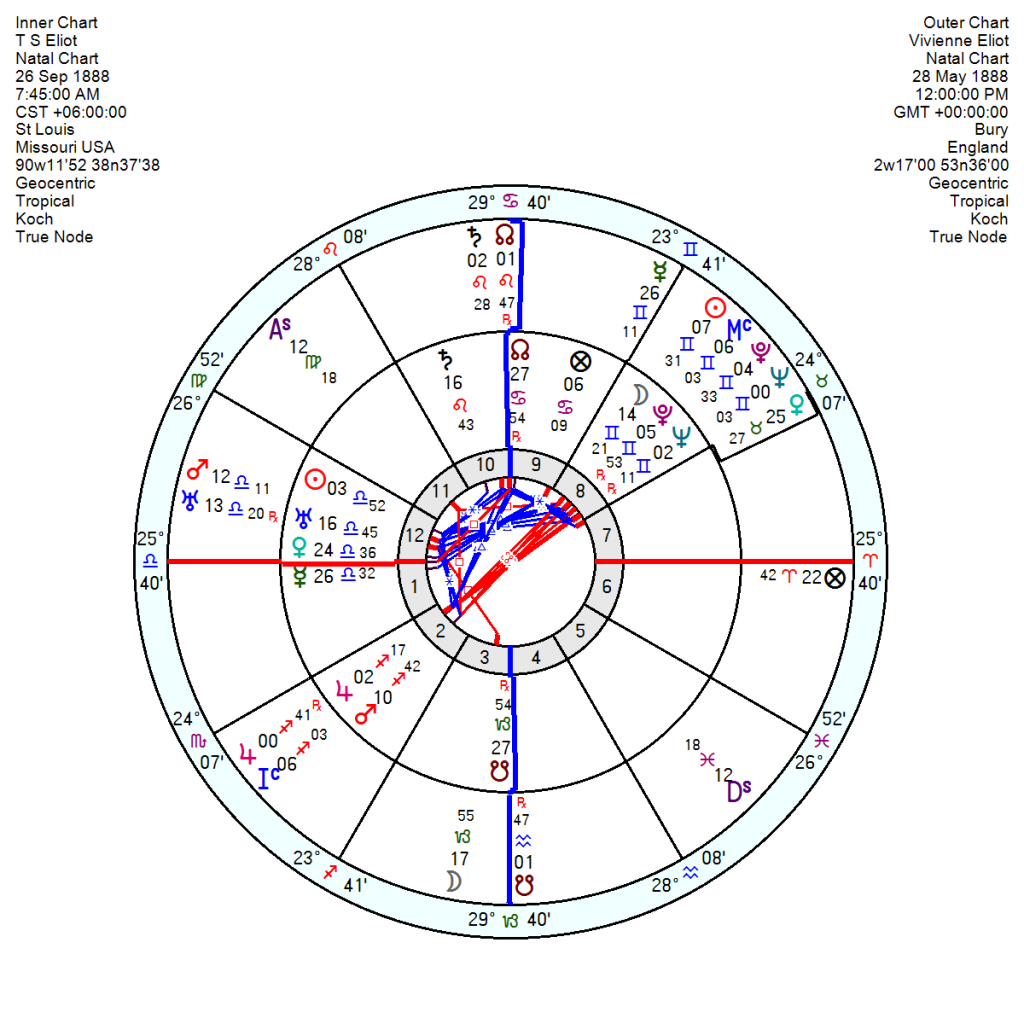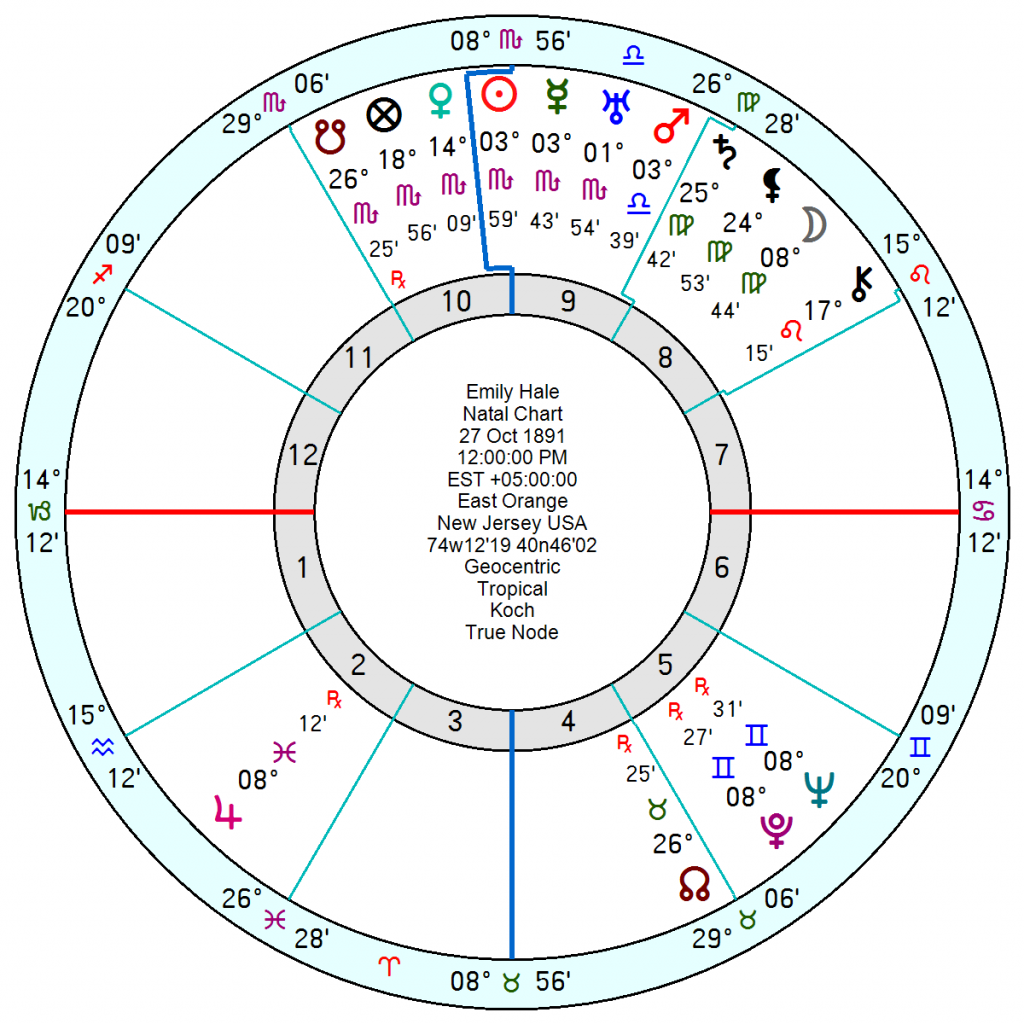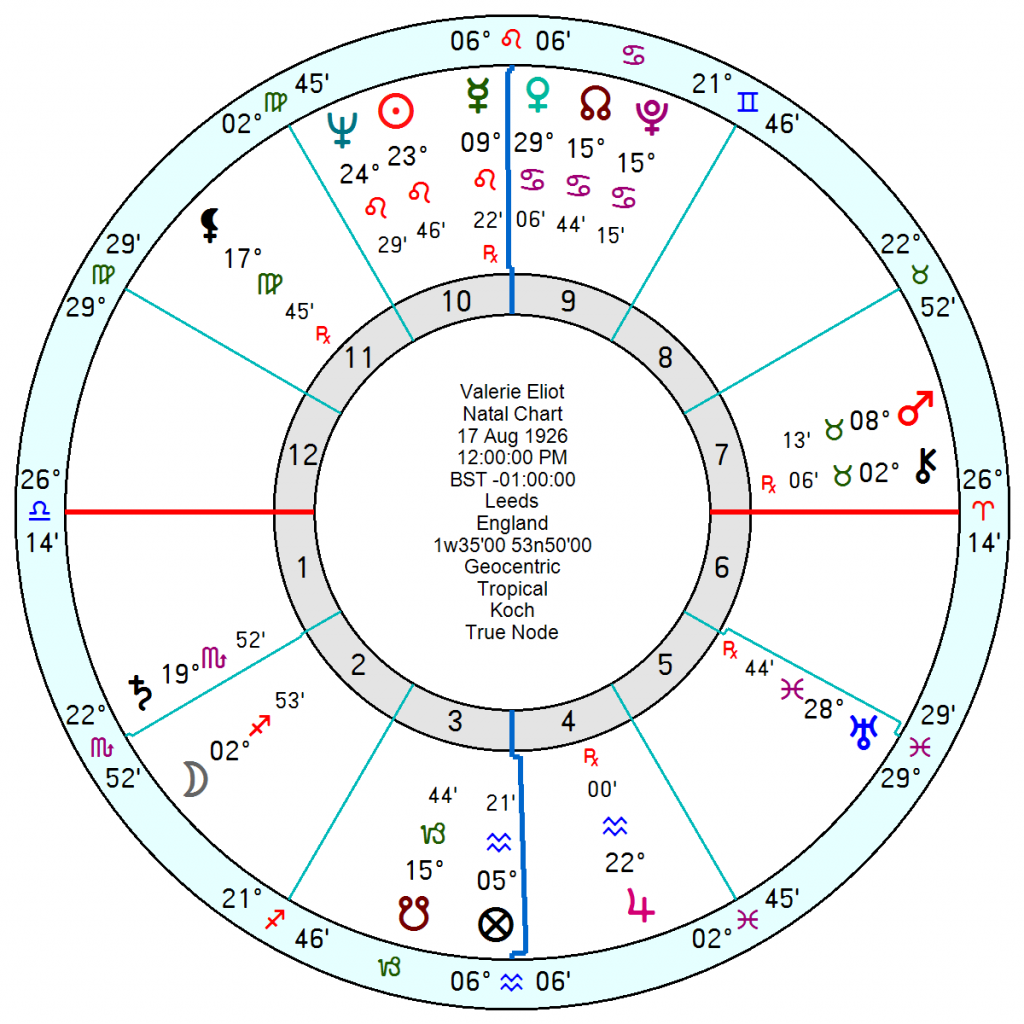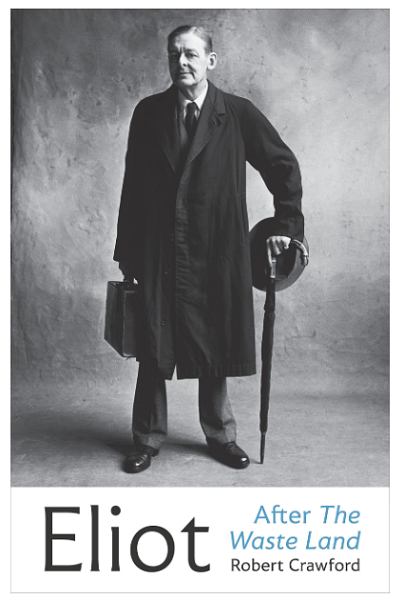



TS Eliot, renowned as the greatest 20th Century poet has imbedded lines from his masterpieces, The Waste Land and Four Quartets into common consciousness.
“Humankind cannot bear very much reality.”
“April is the cruellest month.”
“I will show you fear in a handful of dust.”
Yet the muddle of his private life left the impression of a callous, enigmatic personality. Siegfried Sassoon, his contemporary, described him as “cold-storaged humanity”. He abandoned his unstable first wife in an asylum and never visited her; dazzled an adoring sweetheart for decades with his lovestruck letters but kept her hanging on a string and eventually betrayed her; and towards the end of his life married his secretary forty years his junior. A reviewer remarked that he followed Wordsworth’s pattern where being starved of sex arguably led to his greatest work.
He was born 26 September 1888 7.45 am St Louis, Missouri, and had a 12th house Sun Libra with a highly-strung 12th house Uranus as well and a striking collection of Neptune Pluto and Moon in Gemini in his 8th house which are opposition Mars Jupiter in Sagittarius in his 2nd. He’d have more than his fair share of mental instability to cope with.
The 12th house is the chart area of the unconscious and creativity; and the 8th house for some has this magical ability to influence the masses – for good or for ill since Hitler had the same. King George VI had Neptune Pluto in the 8th opposition Sagittarius planets and he was given to uncontrollable rages. So there was a good deal more emotional turmoil going on in TS Eliot’s life than his stunted relationships might suggest.
Both his first wife Vivienne, 28 May 1888, and his arm’s-length love Emily Hale, 27 October 1891, were born with Neptune Pluto in Gemini prominent. In Vivienne’s case it was conjunct her Gemini Sun so she’d always have been battened down, poor soul, and his treatment of her exacerbated her fragile state of mind. Emily had the Neptune Pluto trine Mars and a stellium with her Sun in intensely emotional Scorpio so she hung on through the years hoping he’d fulfil the promise of his passionate letters.
Valerie, 17 August 1926, whom he eventually married for the final 8 years of his life, had been starstruck with him as a writer since her teens, married him when she was 30 and after his death tended devotedly to his estate for decades. She avoided the fey Neptune Pluto syndrome being a later generation and was a Sun Neptune in Leo opposition Jupiter in Aquarius.
I’ve always thought that the Neptune Pluto conjunction of the late 19th Century, first in Taurus and more importantly in Gemini between 1876 and 1902 had a defining effect on the 20th Century. It’s a curious and can-be terrifying mix of Pluto’s intensity with Neptune’s cosmic yearnings, both intensely sexual and equally rejecting of human desires. It imbues hubris of a stratospheric scale on some who bear its stamp – ambition without limits. It produced epically brutal leaders; fostered art, especially erotic literature and scientific advances in such intangibles as electricity, radio and telephone. As well as megalomaniac ambition, it also has a propensity for scandals.
“I think we are in rats’ alley
Where the dead men lost their bones.”
― T.S. Eliot, The Waste Land.
“I have heard the key
Turn in the door once and turn once only
We think of the key, each in his prison
Thinking of the key, each confirms a prison”
― T.S. Eliot, The Waste Land

Very interesting astro biography. In high school English we studied his work, but there was not a word about the man’s troubled life. I imagine that today, he would be diagnosed with clinical depression and put on happy pills.
It is always fascinating to see how a troubled marital or love life, in the right hands, produces great art. If Thomas Hardy’s wife had not been mentally unstable, and refused to sleep with Hardy, or T S Eliot had ever been happy in love when he was young, would they ever have written the great works they did? If they had had children, would they have had the free time to do all their writing?
Another curious fact about T.S. Eliot is that for all his exceptional braininess, until he became rich and famous he worked in a surprisingly humdrum job in a basement in a branch of Lloyds bank in London – very 12th house. His work mostly involved foreign exchange. His financial expertise was useful later in life when he was a director of Faber and Faber, which also published his poems and plays.
Another genius influenced by Eastern ideologies/psychologies!
My favourite lines are from Burnt Norton (Four Quartets) and comment on the illusory nature of time:
“Time present and time past
Are both perhaps present in time future
And time future contained in time past.
If all time is eternally present
All time is unredeemable.”
I guess we just have to live in the moment.
“It’s a curious and can-be terrifying mix of Pluto’s intensity with Neptune’s cosmic yearnings”
Thanks Marjorie, so interesting – and strange – to see that Pluto/Neptune conjunction in Gemini. 1888, when Eliot was born, featured an intense summer and autumn that year in East London. The Pluto/Neptune opposition Mars and Jupiter he carries and channeled put their stamp on two events that stand out in my mind. Both fit with what you write about the conjunction’s impact on the 20th century.
A famous Match Girls’ Strike took place in July, 1888, which led eventually to improvements in their appalling working conditions at the Bryant and May Factory, and as outworkers at home. Also to much wider public support for workers’ rights. Curiously, an opposition between Mars and Neptune is said in medical astrology to indicate a lack of phosphorous – the key damaging ingredient to workers, used in matches at that time. English Heritage is said to be putting a blue plaque up this year to mark this event, and the courage of the girls and women who went on strike.
And the summer and autumn of that year witnessed the infamous Jack the Ripper murders – two occuring on 30th September. The darkness and violence of the Pluto/Mars and the mystery of the killer who was never caught – plus the Gemini/Sagittarius attentions of the press at the time, and the Neptunian sense of scandal plus that Victorian favourite, sensationalism, have continued to fascinate, repel, and fuel a Ripperology industry ever since.
That’s wonderful, Jane. The Neptune/Pluto conjunction in Gemini is endlessly fascinating to me – I have a Gemini ancestor born with it conjunct their Sun, opposing Uranus in Sagittarius which tied into the rest of their chart to form a Mutable Grand Cross along with Moon in Pisces and Mars in Virgo. They suffered from a lifetime of recurring depression, their father having died suddenly in an accident when they were 9. They had a breakdown on their second Saturn Return and were treated with ECT. My sister and I have inherited their Mars/Pluto – I have Mars sextile Pluto and my sister has the conjunction in Virgo.
But yes, as you point out the year 1888 was significant and the conjunction of Neptune/Pluto that summer was both pivitol in terms of social change as well as technological advances which launched the world into the 20th Century.
The year was phenomenal for ‘first ever’ events which embody the nature of Neptune/Pluto in Gemini: The rise of oil and gas, De Beers Mining company set up, Edweard Muybridge creates the first moving pictures, the first ever successful airship flight, the first trams, the first ever driving license issued, Kodak is registered for a patent for a roll film camera. The ‘first ever’ forensic photograph is taken, led by Scotland Yard detectives on the morning of the discovery of ripper victim, Mary Jane Kelly’s mutilated body at Miller’s Court – a shocking event which coincided with none other than Black Moon Lilith joining the conjunction that day. The ‘Whitehall Mystery’ otherwise know as the ‘London Torso Murders’ occurred – what is it about this sinister year and the denigration and dismemberment of women?
Alan Moore’s graphic novel ‘From Hell’, based on the Whitechapel murders is very in-depth when it comes to this particular year, pointing out it was the year that Buffalo Bill’s Wild West Show completed its tour of the UK, the year that the ‘Elephant Man’, Joseph Merrick was living at the London Hospital under the care of surgeon Frederick Treves, and being visited by the celebrities of the day and the year that Adolph Hitler was conceived. So he sets the backdrop of this remarkable harbinger of a year which is marked by the ingress of Neptune and Pluto into the sign of Gemini.
Correction: I’m not sure the Mary Kelly crime scene photo was the first tbh, but I think it would have been among the earliest of such photos. Advances in crime detection tech took place when the Neptune/Pluto in Gemini was active, certainly fingerprinting (Gemini, the hands) came into being in 1892.
The most famous crime scene photographer I can think of is Weegee (Arthur Fellig) who used short wave radio in order to know where the crime scene was located. Naturally he has the Neptune/Pluto conjunction in Gemini along with Mercury and his Sun, all opposing Chiron/Saturn in Sagittarius. His crime scene photos are Plutonian, dark, shocking, tragic and to my mind are reminiscent of Film Noir, German Expressionist cinema and most certainly the films of Hitchcock, another famous Neptune/Pluto in Gemini supertalent.
Wow VF! Thanks so much for this. What an incredible year rolled out with Neptune and Pluto conjunct. As Marjorie said, ‘a defining effect’. Despite my passion for history, I’d not really taken on board quite how many resonances we can see echoing into the 20th century – Neptune presiding over “trends” Pluto’s power and longevity? John Logie Baird was born in the August – imagine our world and childhood excitements without TV! And more Neptune hovers with the first recorded flicker of film, October 1888, made in Leeds by Louis le Prince. Connects up so well with Muybridge and Kodak you mention.
T. S. Eliot’s 12th house planets (especially Uranus) would have been tuned into the collective in some ways, and bearing the stamp of that year – carrying it forward into the 20th century. No wonder he thought cats had a secret 12th house name to contemplate. Quite right about that though!
And I, too, have an ancestor in our family tree born that summer. Mars/Pluto still crops up in their descendants’ charts, including mine. Their story goes from grim Victorian poverty to success, showing the strength and determination of the aspect I think. There have to be some plus points to Mars/Pluto….
Yes, I also have Uranus in the 12th and it’s conjunct the North Node and Black Moon Lilith, as well as the asteroid Psyche for good measure! As a child I took refuge in my imagination as a way of escape, I invented whole worlds in my head and spent a lot of time in my room, alone reading and drawing, writing little books and illustrating them. I think for T. S. Eliot with his Libra Sun, Uranus, Venus in the 12th, his congenital double inguinal hernia prevented him from physical activities in early childhood (the ruler of his 6th house is conjunct Pluto and the Moon in the 8th), so his interactions with other children were limited. So you can see that isolation with those chilly Air planets in Gemini and Libra and the need give them expression in those deep, collective, watery houses.
Apologies, like Columbo I want to say just one more thing: those of us alive today share one thing in common – we all have the Neptune/Pluto sextile in our natal charts. It’s almost as if we are the inheritors, the great grandchildren of that significant Gemini conjunction and in sextile we have the opportunity to use it in some way. We are all children of this age of advancing technology. The Neptune/Pluto conjunction cycle is 493 years. It last occurred in Gemini in 1398 when it shifted from Taurus to Gemini. It coincided with the start of the European Renaissance which again was a pivotal age of huge importance in every sphere of human achievement.
I’ve noticed how many greatly creative people have had either a weird childhood, or some childhood illness that means they spent a lot of time alone, with few playmates. A difficult time then also seems to foster the charisma of many film stars and musicians etc. It’s the grit in the oyster that makes the pearl?
I like the notion of chilly Air planets expressing through Water. Bubbles?!
“At the still point of the turning world. Neither flesh nor fleshless;
Neither from nor towards; at the still point, there the dance is,
But neither arrest nor movement. And do not call it fixity,
Where past and future are gathered. Neither movement from nor towards,
Neither ascent nor decline. Except for the point, the still point,
There would be no dance, and there is only the dance.”
― T.S. Eliot
The Neptune Pluto exact conjunction happened in 1892/93 with Uranus in Libra/Scorpio.